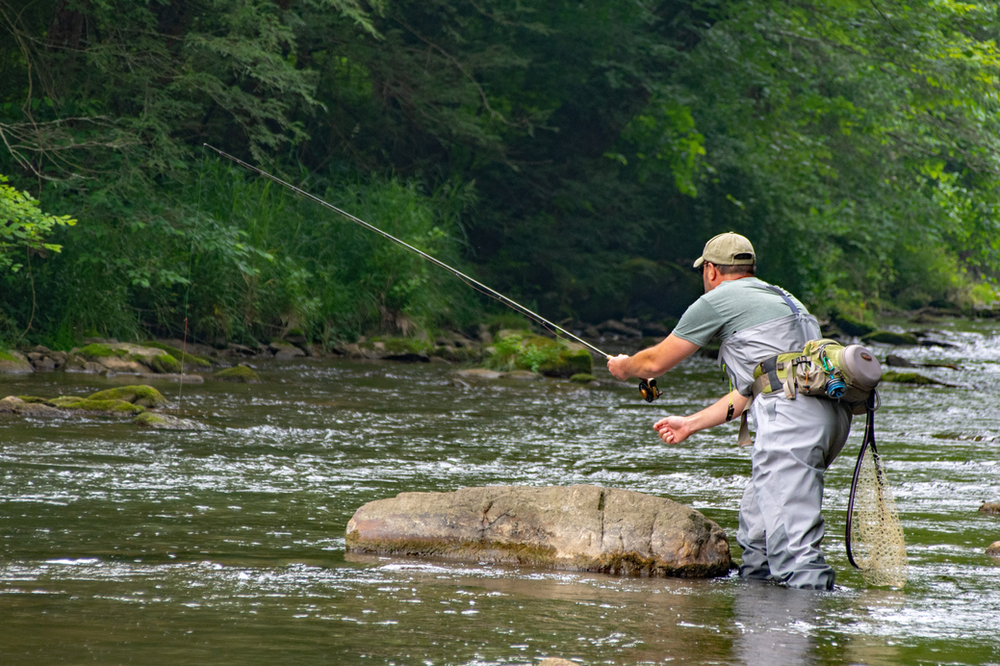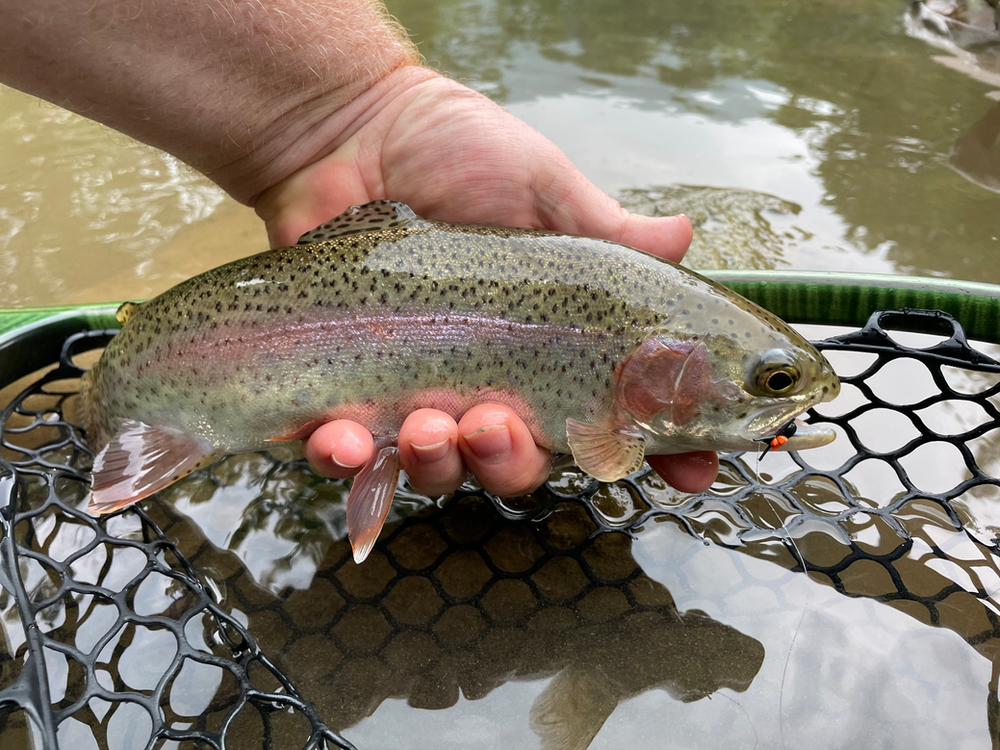A Good Day on Yellow Creek’s Fly Fishing Only Section

Swarms of bugs filled the air and a half dozen or so trout continually fed in front of me. I just couldn’t figure out how to catch them. I tried all the typical patterns, everything from Blue-Winged Olives to Adams to Mole Flies to Midges. The most action came on a size 18 BWO, which made at least two trout inspect it closely before refusing the fly.
The hatch was still going on, big clouds of mayflies flitting in the air, when a guy appeared and asked me how I was doing. After explaining I had yet to catch a fish, he said, “Those are Blue Quills. The trout ignore them. They don’t come back to the water. I hope you brought some terrestrials with you.”
It seems odd to stand in the middle of a mayfly hatch and turn a blind eye, but this is something I’ve heard numerous times while fishing Yellow Creek, and had actually experienced one other time myself. Yellow Creek trout don’t give a darn about Blue Quills. It’s a puzzling phenomenon.
I did as the stranger suggested and tied on a size 16 foam-bodied beetle. He directed me to cast to various positions throughout the pool but nothing took notice of the fly. After watching me make four or five casts, the guy seemed unimpressed with my skills and wished me good luck before walking back to his vehicle.
I worked upstream a few yards and landed a cast right in the middle of the stream. A chunky rainbow pounced on it as soon as the beetle hit the water. I was in such disbelief that a second or two passed before I realized I should set the hook and landed my first trout of the morning.
I caught another rainbow and missed two more before my buddy Justin came down and asked if I felt like stopping for lunch. It was almost 2 o’clock by then and we’d been at it for about three hours. Justin and I each had two trout to our credit, and it felt like we just needed a reset and a plan for the rest of the day.

A foam beetle fooled this chunky rainbow.
Contact Nymping/Euronymphing
Yellow Creek was low, but the water temps were good. The trout were tough, though, which could be a product of the conditions, or just a natural result of fishing later in the season in a special regulations area that is heavily pressured and has a lot of educated fish anyway. Justin and I had each missed multiple fish, and overall the takes were subtle to the point of being almost undetectable.
I’ve always struggled in these scenarios. Justin, however, enjoys contact nymphing, also known as Euro nymphing, and he no doubt had more consistent action than I did. Which is to say, although our catch totals were similar, he had a lot more hits, and with a little luck he’d have caught three or four times more trout than I did.
While on the stream, I had Justin talk a little bit about Euro nymphing while I videoed with my GoPro. Here is a short clip on how to get started Euro nymphing and a few of the general techniques that make it so effective.
Making Adjustments
We got back on the water around 4:30 or so and worked upstream from the parking lot. The afternoon picked up where the morning ended, with more missed trout and frustrations. Justin eventually caught a couple more on nymphs. I headed up to the last big pool near the top of the project water.
I waded halfway out into the stream, stirring up a bunch of mud as I did. As I waited for the water to clear, a trout splashed downstream from me, almost as if tempting me to try to catch it with a dry fly. No, thank you, Mister Trout, I wasn’t about to fall for that trick!
Instead, I pulled a black Woolly Bugger out of my box hoping I could swing it down to the trout and evoke a strike that way. It worked! It was a violent take, in fact, even though that fish shook off, too. I missed two more before bringing in my fly to look it over and make sure the point was sharp. Well, there was the problem. Not only was the point not sharp, it was downright missing!
I’m notorious for beating the crap out of my gear, and I often forget to dry out my fly box after trips — especially trips that include me falling in and getting completely soaked. Several of the flies that have lived in my boxes for a few years and endured this neglect, I noticed, had developed rusted areas around the bend of the hook where the materials began. Basically, the materials had never dried appropriately, and some boxes that I seldom opened, like my bugger box, had multiple flies rendered useless.
“Well isn’t that a kick in the ass,” I said to nobody in particular.
Fortunately, I had a couple good black buggers left and tied one on. I caught a bluegill — yes, a bluegill in Yellow Creek — and two more feisty rainbows in the span of five minutes. Justin worked his way up to me and fished the riffle leading into the pool and caught a wild brown and another rainbow.
It was a by-gosh biting spree!
It was getting late now, so we started working back downstream. That’s when a day of struggle took a turn for the better. It was like a switch had flipped and the trout realized that the black Woolly Bugger was exactly what they wanted.
By then, Justin had switched to a black Woolly Bugger, too. We caught (or lost) at least one fish, and sometimes more, out of every pool we hit all the way back to the vehicles. We ended the day with 9 or 10 apiece but could have easily ended up with at least double that apiece if a few breaks had gone our way and we’d landed many of the trout that had shaken off halfway in.
Summer Fly Fishing Expectations
It’s always hard to know what to expect when fly fishing in the summer. This is a meager time of year for trout in most places in this region. First and foremost, you have to be aware of water temps. Carry a water thermometer on you at all times and don’t fish unless the water is below 68 degrees F. Above that and fish might not recover from the stress of being caught and handled. Sure, they may swim off, but hours and sometimes days later, the stress of the incident will take its toll.
This time of year, trout just don’t feed as aggressively as they did in the spring. Part of that is due to low water, another part is due to the food sources present, and yet another part because they’ve been pressured hard from March through early June. Yellow Creek is a perfect example. Being a limestone-influenced stream, it has great mayfly hatches and consistent year-round fishing, both of which make it a prime destination for anglers all season long. All you have to do is note the well-worn trails following the stream to know that Yellow Creek is not a lightly-fished water.
Although Yellow Creek is still a quality fishery with a healthy population of wild and stocked trout, you have to go into the day with tempered expectations. There will be days when the fishing is relatively easy and you have the right fly to match the situation, but other days it take some patience and constant fly changes to find something that works. And that’s not just on Yellow Creek; that’s anywhere this time of year.
________________________________
Have you checked out our Stream Reports? These are quick overviews of some of our favorite waters in the region. Find access points, hatch information, and links to USGS gauges and other resources before planning your next adventure.
